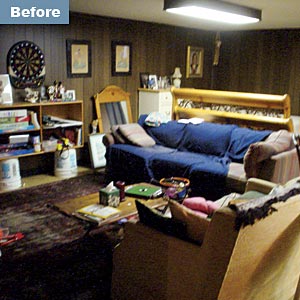 |
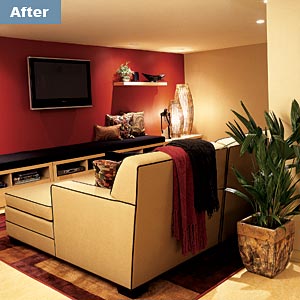 |
|
The project features environmentally friendly choices alongside visually friendly ones. The vivid red wall (painted with non-toxic paint) warms up the muted, monochromatic space, which in turn is kept warm and quiet with eco-smart blown-in soy insulation. |
|
Sheila Donlan’s Deerfield ranch house had a typical suburban basement: a 483-square-foot room containing a jumble of tired furniture and clutter exiled from the rest of the house. Decorative items included a dartboard and a shelving unit propped up on plastic buckets. Wood paneling and dark-blue drapes gave the space "a kind of creepy-basement feeling," Donlan says.
Last spring, she decided it was time for a change. She wanted a safe and private place for her teenage daughter, Sonja, and her friends to hang out. And while she was at it, Donlan decided to go as green-environmentally speaking-as possible.
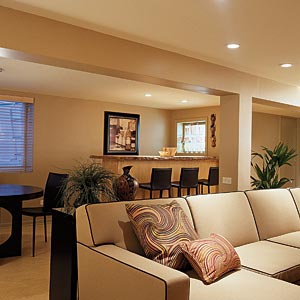 |
|
A sectional sofa, custom-made with recycled lumber and fabric, is the basement’s most expensive touch. |
She enlisted Karen Kaplan, owner of New Leaf Interiors in Skokie, to help with a floor-to-ceiling remodel. Kaplan specializes in green spaces (she was instrumental in the initiation and design of the country’s first green synagogue, under construction in Evanston) and is committed to using eco-friendly materials and finishes whenever possible.
While a contractor cleared the space down to the studs, Kaplan created two possible color schemes, one with bright jewel tones and the other with a more subdued, "serene and green" palette. Donlan chose the muted scheme with jewel-tone accents; Kaplan carried it out with a floor of mottled tan-and-caramel Marmoleum Click (a concoction of wax, sawmill dust, linseed oil, rosins, and jute), no-VOC (volatile organic compounds) paint in tan and oxblood red, a bar with bamboo cladding and a repurposed-ash slab top, and a sectional sofa with a reclaimed-urban-lumber frame covered in fabric made from recycled plastic pop bottles.
Custom-made, the cream sofa cost around $15,000-money well spent, from the looks of it. "You don’t have to use ugly fabric to be green," says Kaplan, who was inspired by a multicolored recycled-fabric throw pillow when choosing colors for the sofa’ s piping, the area rug, and other decorative items around the room. She picked up some of the ethnic pieces at Ten Thousand Villages in Evanston; Donlan bought others, including tribal masks from Peru and Brazil, while traveling. The global touches "work with the theme of being green and socially aware," Kaplan says.
The idea continues in the sage-and-cream full bath, with its countertop made from recycled toilet porcelain (crushed and sterilized) bound with epoxy. Birch storage cabinets contain no VOCs or formaldehyde.
While 80 percent of Kaplan’s design choices were green, economics and aesthetics forced a few mainstream choices. For instance, the geometric-print area rug is good old-fashioned Olefin, a high-quality synthetic ("a wool rug would have blown the budget," she says). Low, wide storage shelves along one wall are from Ikea; they fit both the space and the budget perfectly, says Kaplan. And recessed lighting is incandescent, not fluorescent, because at the time of construction, compact fluorescent bulbs were unavailable in dimmable models.
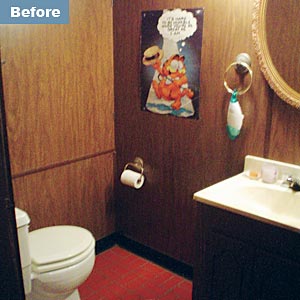 |
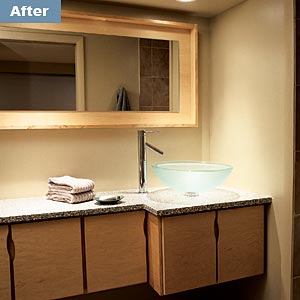 |
|
The green theme continued into the bathroom, where the countertop is made from recycled toilet porcelain bound with epoxy. The birch cabinets are free of both VOCs and formaldehyde. |
|
The project spanned four months and cost about $40,000, Kaplan says. Both mother and daughter are pleased. "When I was little, I thought there were ghosts down here," Sonja says. "It’s so much more inviting now." She and her friends frequently use the space for gabfests and hair-and-makeup sessions.
Meanwhile, Mom, puttering around upstairs, enjoys a "green and serene" feeling of her own. The new teen hangout "brings a little peace to our relationship," she says.
For information on resources, see Buyer’s Guide.
Photography: Kate Roth



